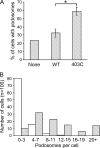A Polymorphic Variant of AFAP-110 Enhances cSrc Activity
- PMID: 20689769
- PMCID: PMC2915419
- DOI: 10.1593/tlo.10106
A Polymorphic Variant of AFAP-110 Enhances cSrc Activity
Abstract
Enhanced expression and activity of cSrc are associated with ovarian cancer progression. Generally, cSrc does not contain activating mutations; rather, its activity is increased in response to signals that affect a conformational change that releases its autoinhibition. In this report, we analyzed ovarian cancer tissues for the expression of a cSrc-activating protein, AFAP-110. AFAP-110 activates cSrc through a direct interaction that releases it from its autoinhibited conformation. Immunohistochemical analysis revealed a concomitant increase of AFAP-110 and cSrc in ovarian cancer tissues. An analysis of the AFAP-110 coding sequence revealed the presence of a nonsynonymous, single-nucleotide polymorphism that resulted in a change of Ser403 to Cys403. In cells that express enhanced levels of cSrc, AFAP-110(403C) directed the activation of cSrc and the formation of podosomes independently of input signals, in contrast to wild-type AFAP-110. We therefore propose that, under conditions of cSrc overexpression, the polymorphic variant of AFAP-110 promotes cSrc activation. Further, these data indicate amechanismby which an inherited genetic variation could influence ovarian cancer progression and could be used to predict the response to targeted therapy.
Figures








Similar articles
-
PI3K activation is required for PMA-directed activation of cSrc by AFAP-110.Am J Physiol Cell Physiol. 2007 Jul;293(1):C119-32. doi: 10.1152/ajpcell.00525.2006. Epub 2007 Mar 14. Am J Physiol Cell Physiol. 2007. PMID: 17360811
-
Protein expression levels of the Src activating protein AFAP are developmentally regulated in brain.J Neurobiol. 2003 Feb 15;54(3):473-85. doi: 10.1002/neu.10143. J Neurobiol. 2003. PMID: 12532398
-
Analysis of the role of the leucine zipper motif in regulating the ability of AFAP-110 to alter actin filament integrity.J Cell Biochem. 2004 Feb 15;91(3):602-20. doi: 10.1002/jcb.10725. J Cell Biochem. 2004. PMID: 14755689
-
The actin filament-associated protein AFAP-110 is an adaptor protein that modulates changes in actin filament integrity.Oncogene. 2001 Oct 1;20(44):6435-47. doi: 10.1038/sj.onc.1204784. Oncogene. 2001. PMID: 11607843 Review.
-
Appropriate Management of Attenuated Familial Adenomatous Polyposis: Report of a Case and Review of the Literature.Dig Dis. 2019;37(5):400-405. doi: 10.1159/000497207. Epub 2019 Mar 5. Dig Dis. 2019. PMID: 30836352 Review.
Cited by
-
Long noncoding RNA AFAP1-AS1, a potential novel biomarker to predict the clinical outcome of cancer patients: a meta-analysis.Onco Targets Ther. 2016 Jul 12;9:4247-54. doi: 10.2147/OTT.S107188. eCollection 2016. Onco Targets Ther. 2016. PMID: 27471399 Free PMC article.
-
Actin filament-associated protein 1 is required for cSrc activity and secretory activation in the lactating mammary gland.Oncogene. 2015 May 14;34(20):2640-9. doi: 10.1038/onc.2014.205. Epub 2014 Jul 21. Oncogene. 2015. PMID: 25043309 Free PMC article.
References
-
- Naora H, Montell DJ. Ovarian cancer metastasis: integrating insights from disparate model organisms. Nat Rev Cancer. 2005;5:355–366. - PubMed
-
- Jemal A, Siegel R, Ward E, Murray T, Xu J, Thun MJ. Cancer statistics, 2007. CA Cancer J Clin. 2007;57:43–66. - PubMed
-
- Pal T, Permuth-Wey J, Betts JA, Krischer JP, Fiorica J, Arango H, LaPolla J, Hoffman M, Martino MA, Wakeley K, et al. BRCA1 and BRCA2 mutations account for a large proportion of ovarian carcinoma cases. Cancer. 2005;104:2807–2816. - PubMed
-
- Risch HA, McLaughlin JR, Cole DE, Rosen B, Bradley L, Fan I, Tang J, Li S, Zhang S, Shaw PA, et al. Population BRCA1 and BRCA2 mutation frequencies and cancer penetrances: a kin-cohort study in Ontario, Canada. J Natl Cancer Inst. 2006;98:1694–1706. - PubMed
-
- Goldstein DB, Cavalleri GL. Genomics: understanding human diversity. Nature. 2005;437:1241–1242. - PubMed
Grants and funding
LinkOut - more resources
Full Text Sources

